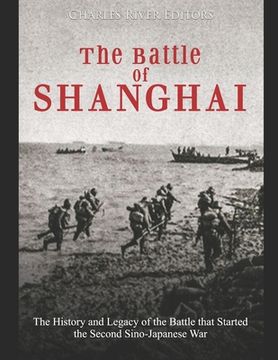The Battle of Shanghai: The History and Legacy of the Battle that Started the Second Sino-Japanese War
Synopsis "The Battle of Shanghai: The History and Legacy of the Battle that Started the Second Sino-Japanese War"
*Includes pictures*Includes a bibliography for further readingOn October 29, 1937, a large crowd of people gathered on the bank of the Wusong River in Shanghai to watch a spectacle, a life and death struggle unfolding directly in front of them across the river. The crowd was a curious blend of Chinese, European, and American civilians and journalists. Their focus was on the Sihang Warehouse across the river, but it wasn't the warehouse itself that fascinated the onlookers. Instead, it was the men inside the warehouse, the men of the 524th Regiment, the 88th Division of the Chinese Nationalist Army. The soldiers were elite, and they were widely considered the best of the Nationalist Army. They proudly called themselves "the Generalissimo's Own," after Jiang Jieshi, the generalissimo of the Nationalist government and leader of China. The Chinese soldiers were prepared to fight and die to the last man, and they were making their last stand there. By then, the city of Shanghai was in shambles. The Imperial Japanese Military had invaded Shanghai on August 13, 1937, rapidly reducing the once-prosperous city to a pile of burning rubble after three months of brutal urban combat. Countless blazing fires raged throughout the city, some of which had been caused by the fighting, but most had been set by the retreating Chinese Army in a futile effort to stall the Japanese invaders. The Chinese Nationalist Army had fought valiantly against the Japanese, but the Chinese were hopelessly outgunned. Possessing few heavy weapons, aircraft, and artillery, the Nationalist Army could not hope to defeat the Japanese, who possessed superior firepower in every engagement against the Chinese troops. Causality rates for the Nationalist Army were horrific, with some units being completely wiped out in the fighting. Many Nationalist Army units would be completely annihilated in the three months of house-to-house fighting. As spectators watched from across the river, a barrage of Japanese artillery slammed the warehouse, creating enormous craters on the walls and sending shockwaves throughout the building. The Sihang Warehouse was six stories tall and made from thick concrete, making it the ideal building to defend against an enemy with superior firepower, but the Chinese soldiers could only hope to hold out for so long. The bulk of their army had already retreated, leaving the 524th the only Chinese unit left in the city. Rubble and the smell of cordite filled the air around the warehouse as the Japanese pressed their attack. Light tanks supported waves of infantry as the might of Imperial Japan focused its rage against a single Chinese warehouse. People watched nervously from across the river as the Japanese soldiers advanced. Some bystanders put up large signs bearing Chinese characters large enough to be seen across the river like some bizarre sporting event. They were mean to warn the soldiers in the warehouse of any approaching Japanese attacks. There were whispers among the people watching that the soldiers in the warehouse were called "The Lost Battalion." The Western newspapers had dubbed the battle for the warehouse the Chinese Alamo. The Battle of Shanghai was a brutal testament to a new era of modern warfare which, according to many historians, signified the beginning of the Second Sino-Japanese War, and hence World War II. Despite the stand, China was a nation broken into petty warlord fiefdoms and wracked by civil war between Nationalist and Communist forces. This civil war became inextricably intertwined with the Second Sino-Japanese War and World War II, and the sheer scale of the horrors of the conflict remain hard to believe today, even as action in that theater is often overlooked because of events in Europe. Indeed, the Japanese launched a brutal campaign across the fragmented realms that made up China, committing atrocities just as horrendous as their Axis ally in Europe.

